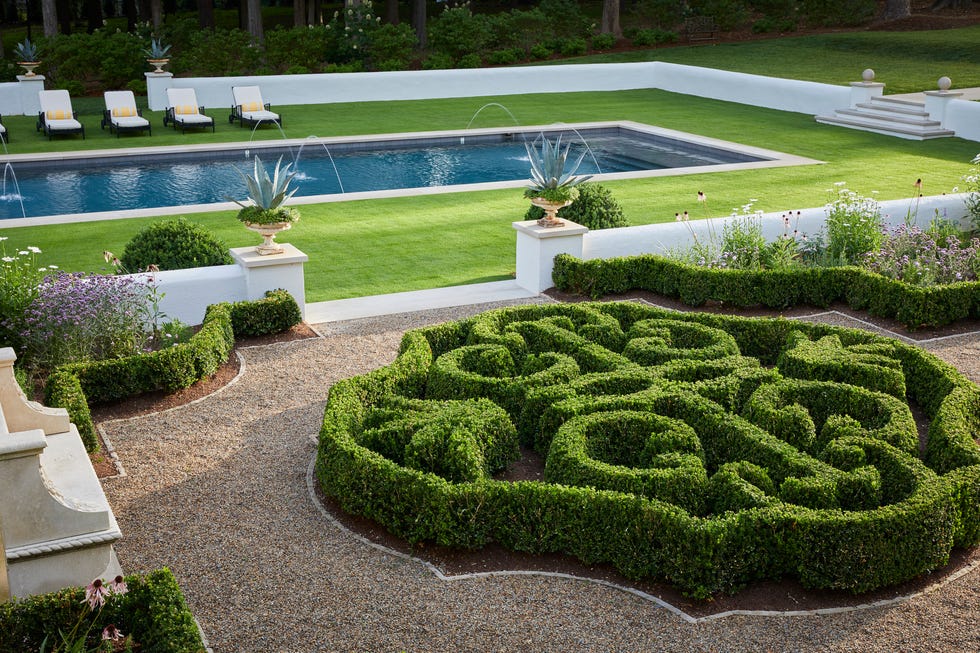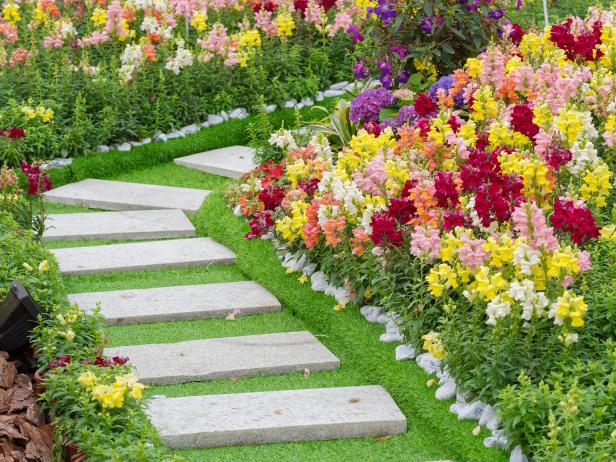Exploring Various Sorts Of Landscape Design to Improve Your Outdoor Environment
Landscape design plays an important duty in specifying outside rooms. Different styles, from conventional gardens to contemporary minimalist designs, use distinct advantages for enhancing visual appeals and function. Including elements like xeriscaping and indigenous plants can add to ecological equilibrium. Comprehending the interplay of hardscape and softscape is important for producing welcoming environments. The choices offered can be frustrating, prompting one to show on which style finest straightens with their vision for an outside sanctuary.
Standard Yard Landscape Design

While numerous modern gardens welcome minimalism and native growings, typical garden landscaping continues to be a treasured strategy that emphasizes balance, structure, and ornamental features. This style usually incorporates official geometric layouts, where bushes, pathways, and flowerbeds are set up with precision. Central centerpieces, such as sculptures or fountains, draw the eye and supply a feeling of harmony.Traditional landscaping often includes a range of plant types, showcasing seasonal blossoms and evergreen aspects. Classic shrubs, perennials, and annuals develop dynamic colors and structures throughout the year. Additionally, pergolas, trellises, and arcs add vertical passion and work as assistance for climbing plants, boosting the general aesthetic.The usage of all-natural products, such as stone and wood, additional improves the standard landscape, adding to an ageless top quality. Eventually, this design invites leisure and enjoyment, making it a beloved option for those looking for an attractive exterior atmosphere.
Modern Minimalist Landscaping
Modern minimal landscaping stresses simplicity and capability, identified by open rooms and tidy lines. Key attributes consist of a restricted plant scheme and thoughtful hardscape style that focuses on functionality and visual appeal. Effective plant selection techniques further boost the minimal approach, developing relaxing outside settings that encourage relaxation and contemplation.
Trick Attributes of Minimalism
An expanding fad in landscaping is the welcome of minimalism, characterized by simplicity and performance. Minimal landscaping concentrates on tidy lines, open spaces, and a restricted color palette, advertising a sense of peace. Elements are thoroughly curated to prevent mess, allowing each element to stick out. Using all-natural materials, such as stone and wood, boosts the organic feel while keeping an aesthetic equilibrium. In addition, minimal styles frequently incorporate geometric forms, which can create visual rate of interest without overwhelming the senses. Water attributes might be included, acting as focal factors that improve tranquility. Generally, minimalism in landscape design highlights the beauty of restriction, allowing nature's integral high qualities to radiate through in an unified exterior atmosphere.
Plant Option Approaches
Reliable plant selection is essential for accomplishing the preferred visual in modern minimalist landscape design. The focus should get on simpleness, making use of a limited scheme of plants that complement each other and the surrounding setting. Native plants are commonly perfect, as they require much less maintenance and water, advertising sustainability. Selecting species with differing textures and elevations can add aesthetic interest without overwhelming the space. Organizing plants in collections as opposed to scattering them enhances communication and reinforces the minimal style. Evergreen varieties can offer year-round structure, while seasonal blossoms present subtle color adjustments. Eventually, the objective is to develop a peaceful outdoor room that personifies peace and consistency via thoughtful plant choices.
Hardscape Style Principles
Necessary components in hardscape design significantly add to the general looks and functionality of minimalist landscaping. This style technique emphasizes clean lines and underrated products, producing a minimalist aesthetic experience. Secret elements consist of paths, patio areas, and maintaining wall surfaces, which not just define spaces yet likewise improve accessibility and functionality. The use of products such as concrete, rock, and wood is prevalent, mirroring a natural yet contemporary aesthetic. Incorporating symmetrical designs and geometric shapes further enhances the minimal approach, enabling for an unified blend with surrounding plant. Additionally, appropriate drainage and disintegration control are vital factors to consider, making sure long life and sustainability. Ultimately, efficient hardscape design acts as a structure that matches softscape elements while keeping equilibrium and simplicity in exterior settings.
Cottage-Style Landscaping
Cottage-style landscaping uses a wonderful technique to creating welcoming outside areas. By integrating captivating plant combinations, this design fosters a feeling of heat and whimsy. The emphasis on cozy, well-defined areas encourages relaxation and enjoyment of nature.
Captivating Plant Combinations
Although several home owners look for to develop a picturesque outdoor room, attaining the appeal of cottage-style landscaping usually pivots on thoughtful plant combinations. Vivid blooms, rich vegetation, and aromatic herbs can be artfully paired to stimulate a sense of whimsy and fond memories. Integrating lavender, daisies, and foxgloves develops a vibrant tapestry that draws in pollinators while supplying a fascinating fragrance. Integrating decorative grasses like miscanthus can add texture and movement, enhancing the softer blossoms. Additionally, mixing annual and seasonal plants guarantees constant shade throughout the seasons. The usage of mountain climbers, such as clematis or honeysuckle, can enhance vertical passion. In general, these combinations not only improve the landscape however likewise cultivate a captivating and inviting environment.

Relaxing Outside Rooms
Producing cozy exterior rooms needs a cautious mix of convenience and appeal, matching the lively plant combinations located in cottage-style landscaping - Grill Islands. These locations usually include inviting seating arrangements, such as weather-beaten wooden benches or supported chairs surrounded by rich plant. Soft lights, like fairy lights or lights, adds warmth, changing the space right into a peaceful retreat. Integrating elements such as trellises adorned with climbing roses or great smelling natural herbs enhances sensory experiences. Additionally, paths made from rustic stones invite exploration and link with nature. Ornamental touches like birdbaths or wayward garden art contribute to a feeling of fancifulness. Inevitably, the goal is to develop a captivating environment that motivates leisure and satisfaction of the beauty bordering these comfy outdoor places
Xeriscaping for Water Conservation
How can areas balance visual landscape design with the pressing requirement for water conservation? Xeriscaping arises as a practical service, promoting sustainable practices that minimize water use while enhancing outdoor appeal. This landscaping method focuses on utilizing drought-resistant plants belonging to the area, which call for substantially less water than conventional gardens. By incorporating compost and effective watering systems, about his xeriscaping reduces evaporation and drainage, more preserving valuable water resources.Communities can develop visually enticing landscapes via careful preparation, selecting a varied variety of structures and shades that flourish in arid problems. Furthermore, xeriscaping urges making use of decorative rocks and decorative gravel, offering practical and eye-catching choices to grass yards. As neighborhoods embrace this environment-friendly strategy, they not only reduce their water consumption but likewise advertise biodiversity and durability in their regional communities. Inevitably, xeriscaping offers as a demonstration of the consistency in between aesthetic charm and environmental obligation.
Hardscape Design Aspects
Hardscape layout aspects play an important duty in boosting exterior spaces by providing framework and performance. These non-plant features, such as patios, sidewalks, decks, and wall surfaces, develop visual passion while offering sensible functions. Making use of products like concrete, brick, and rock, hardscaping adds to the total visual charm and toughness of a landscape.Incorporating hardscape components can define locations within a lawn, guiding motion and urging social communication. A well-placed pathway can link different areas of the garden, while keeping wall surfaces can take care of elevation adjustments and stop erosion.Furthermore, hardscape design can enhance ease of access and safety, offering steady surfaces for lounging or strolling. Reliable assimilation of hardscape elements enhances soft landscaping, ensuring a well balanced outside atmosphere. Ultimately, thoughtful hardscape design enhances not only the elegance of outdoor rooms however additionally their use, making them extra inviting and useful for property owners and visitors alike.
Outside Living Rooms
While outdoor home use a smooth mix of convenience and nature, they offer as vital expansions of a home, enhancing way of living and recreation. her explanation These areas can include outdoor patios, decks, or exterior kitchen areas, designed to cultivate relaxation and amusement. Landscape Lighting Installer. By incorporating useful furniture and stylish decor, home owners create welcoming ambiences for celebrations or quiet evenings.The integration of shade frameworks, such as awnings or pergolas, protects versus the components while keeping an open feel. Fire pits and exterior heating systems expand functionality right into cooler months, supplying heat and atmosphere. Additionally, including illumination attributes improves the room's functionality after sundown, developing a wonderful evening atmosphere.Landscaping components, such as borders and pathways, further define these locations, leading motion and including aesthetic charm. Ultimately, exterior home change backyards into flexible resorts, advertising a way of living that welcomes both nature and convenience
Indigenous Plant Landscape Design
Native plant landscape design stresses making use of indigenous flora to produce sustainable and harmonious outside environments. This approach not only improves biodiversity however also preserves water and decreases the need for chemical fertilizers and chemicals. By picking plants that are indigenous to a details area, home owners can guarantee that their landscapes are well-adapted to regional dirt and climate problems, resulting in lower maintenance requirements.Additionally, indigenous plants offer vital environments for neighborhood wild animals, consisting of , birds, and butterflies, promoting ecological wellness. Landscape develops that pop over to this site incorporate these plants usually feature naturalistic layouts that simulate neighborhood communities, cultivating a local color and connection to the environment.Furthermore, native plant landscape design can contribute to dirt stability and erosion control, making it an eco responsible option. Overall, this method not just beautifies exterior areas yet likewise sustains the neighborhood ecosystem, producing a lasting balance between human task and nature.

Often Asked Inquiries
Exactly How Can I Select the Right Landscaping Style for My Home?
Selecting the appropriate landscaping design for a home includes reviewing the residential property's design, environment, and personal preferences. Outdoor Lighting Installer. Researching different designs and seeking advice from professionals can offer guidance to develop a harmonious outside room customized to specific needs
What Is the Average Expense of Expert Landscape Design Solutions?
The typical expense of specialist landscaping services usually ranges from $1,000 to $5,000, depending on job size, complexity, and area. House owners need to consider getting numerous quotes to assure they obtain reasonable rates and top quality solution.
Just how Commonly Should I Keep My Designed Yard?
The regularity of preserving a landscaped backyard generally depends on the attributes and plants present. Typically, routine upkeep every few weeks is encouraged, with seasonal jobs enhancing in frequency during top growing seasons for perfect health and wellness and aesthetic appeals.
Are There Landscaping Alternatives for Little Urban Spaces?

Various landscaping choices exist for small urban rooms, including vertical gardens, container plants, and rooftop gardens. Integrating these components can maximize restricted locations while supplying greenery, enhancing aesthetic appeals, and enhancing air quality in metropolitan atmospheres.
What Plant kingdom Are Best for Bring In Local Wild Animals?
The very best plants for bring in local wild animals include native blooming types, berry-producing bushes, and varied lawns. These plants offer important food and habitat, cultivating a flourishing community that supports different birds, insects, and small creatures. Several homeowners seek to develop a stunning outside area, accomplishing the charm of cottage-style landscaping usually pivots on thoughtful plant combinations. Creating relaxing outside rooms needs a careful blend of comfort and appeal, matching the vibrant plant mixes found in cottage-style landscaping. Native plant landscape design stresses the use of aboriginal plants to create lasting and harmonious exterior settings. Landscape develops that include these plants usually feature naturalistic formats that simulate neighborhood ecosystems, cultivating a sense of place and link to the environment.Furthermore, native plant landscaping can add to dirt stability and erosion control, making it an eco responsible option. Various landscaping options exist for tiny metropolitan areas, consisting of upright gardens, container plants, and rooftop yards.